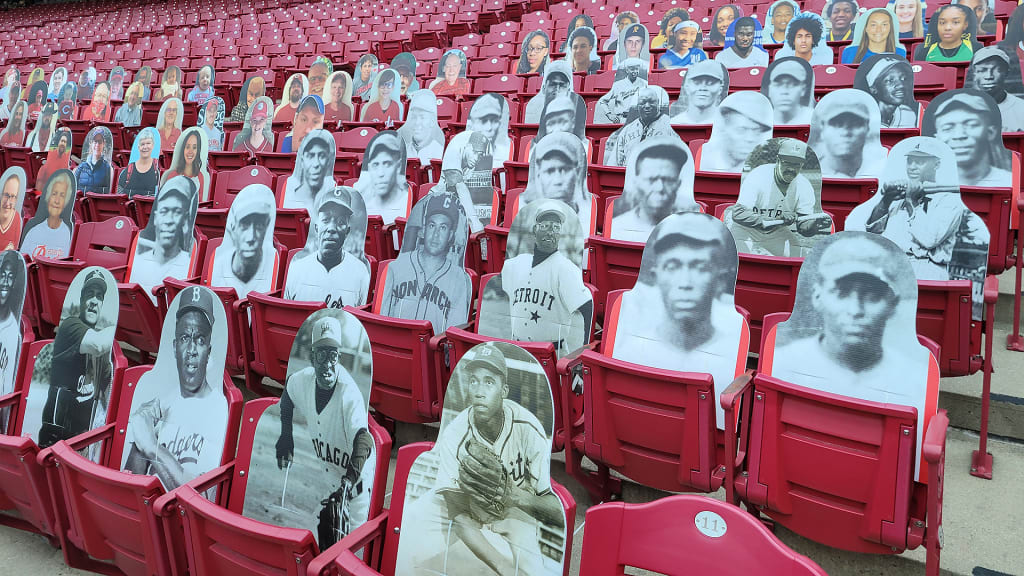
On Sunday, Aug. 30, the Cincinnati Reds celebrated the 100th anniversary of the founding of the Negro Leagues.
The Reds were originally scheduled to join with Major League Baseball and the 29 other teams to honor the Negro Leagues on Aug. 16, but their game against the Pirates was postponed due to COVID-19. Recognizing the importance of this centennial, the Reds quickly moved to reschedule their celebration for Aug. 30.
Reds players wore special anniversary patches on their uniforms, the commemorative logo appeared on base jewels and lineup cards, and pregame videos and graphics were shown throughout the ballpark.
Photo cutouts were placed in the stands featuring some of the important figures of the Negro Leagues, specifically from the Queen City’s own Cincinnati Tigers along with local stars Charlie “Whip” Davis, Don “Groundhog” Johnson and Ron “Bunny” Warren.
Other cutouts in the stands include two groundbreaking players: Jackie Robinson and Chuck Harmon. Robinson, who was celebrated on Friday night, was the first African American in the Major Leagues and paved the way for others like Harmon, the first Black player to take the field for the Reds.
In addition, the players continued to wear the No. 42 uniform stemming from Friday’s Jackie Robinson Day as an extended honor to the baseball pioneer as well as a tribute to the late actor Chadwick Boseman, who portrayed Robinson in the movie “42.”
The Negro Leagues remain a vital part of baseball history. Originally, Black players played alongside white players on professional teams in the late 1800s. Nationwide racism and Jim Crow laws changed this by 1900, forcing Black players off these teams and leading them to form their own teams and travel around the country to play anyone up for the challenge.
It wasn’t until 1920 that an organized league structure was established. Andrew “Rube” Foster spearheaded the initial efforts, and the Negro National League was formed. This created a ripple effect as rival leagues started to form, and the Negro Leagues became a vital source of economic development (and high-level baseball) in Black communities.
“Rube Foster would be my hero,” Reds first-base coach Delino DeShields said. “Looking back at that time period when they started the Negro Leagues, it was just amazing what they did with such little resources. They didn’t have a lot of money, there wasn’t a lot of things available to them at the time, but they pulled it all together, created this league and did something really fabulous for the Black community.”
The Cincinnati Tigers were the most prominent of the Negro League teams from Greater Cincinnati. They were formed in 1937 by Cincinnati native DeHart Hubbard. The Tigers played their home games at Crosley Field, renting the ballpark from the Reds and playing while the team was on the road. They even wore Reds road uniforms from previous seasons. Crowds of 5,000 to 10,000 typically gathered at Crosley for these games, though some games would draw as many as 15,000. By comparison, the Reds were averaging fewer than 6,000 at their games that season. The Tigers put a competitive product on the field and finished in third place. Even with their on-field success and more than respectable attendance numbers, 1937 proved to the first and final season for the Cincinnati Tigers.
The Negro Leagues Baseball Museum in Kansas City, Mo., is the world’s only museum that preserves and celebrates this critically important yet often forgotten part of both baseball and American history. The Reds Hall of Fame brought some of this history to Cincinnati with its “Shades of Greatness” exhibit, which it had on loan from Kansas City from February through July of this year.
To this day, the Negro Leagues Museum hosts an annual awards event called the Hall of Game, which honors former Major League Baseball greats from the post-Negro Leagues era who played with the same passion, determination, skill and flair exhibited by the heroes of the Negro Leagues. In 2019, along with Fred McGriff, Dave Parker and Dave Stewart, Reds Hall of Famer Eric Davis was named an honoree.
“It was the first time I’ve been to the Hall of Fame in Kansas City, and it was breathtaking,” Davis said. “I thought I knew a little bit about the Negro Leagues, but when I took the tour and was able to witness that … Every kid should go to the Negro Leagues Museum, because every statue, every step signifies something that was important about the movement.”

